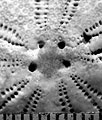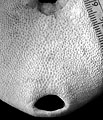The Echinoid Directory
Contributed by Dinesh Srivastava, December 2008
Echinolampas pipurensis Srivastava and Singh, 1999, p. 28
| Diagnostic Features |
|
|---|---|
| Distribution | Nummulites maculatus Zone, middle Eocene; Kachchh (Gujarat), India. |
| Type | Holotype No. KTE 274; Paratypes Nos. KTE 268 (found near village Mori, Kachchh (Gujarat), India) and KTE 275. Museum, Centre of Advanced Study in Geology, University of Lucknow, Lucknow. |
| Classification and/or Status | Cassiduloida; Echinolampadidae A species of Echinolampas Gray, 1825 |
| Remarks | Echinolampas pipurensis is close to E. nummulitica Duncan and Sladen described from the Kirther sediments of Sind (Duncan & Sladen, 1882-1886) except that it has short petals and all have identical width. E. pipurensis differs from E. sindensis d' Archiac described from the Kirther sediments of Sind (Duncan & Sladen, 1882-1886) in having anteriorly excentric peristome. Duncan, P. M. and Sladen, W. P., 1882-1886. Fossil Echinoidea of Western Sind and the Coast of Biluchistan and of the Persian Gulf, from Tertiary formations. Palaeontologia Indica, Ser. 14 1(3), p. 167, pl. 30, figs. 12-15; p. 159, pl. 21, figs. 1-10. Srivastava, D. K. and Singh, S. K., 1999. Echinolampas- a cassiduloid echinoid from the Tertiary rocks of Kachchh, India. Journal of the Palaeontological Society of India 44, p. 28, pl. III, figs. 1-3. |





